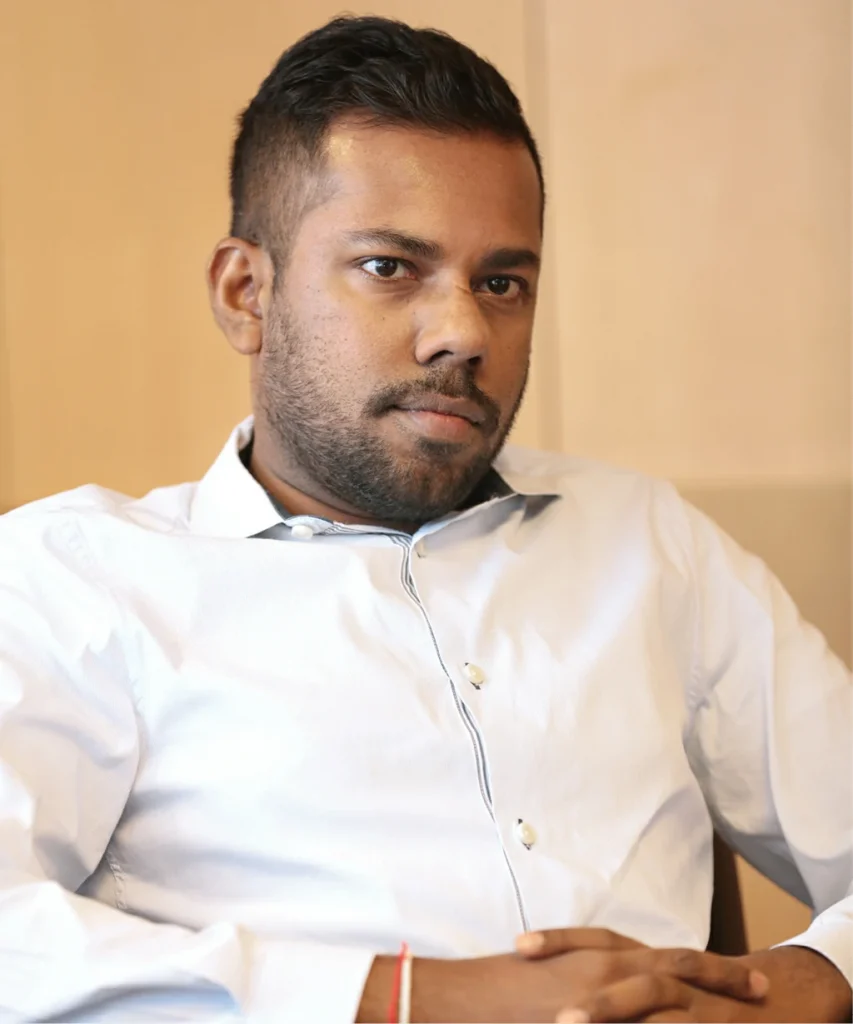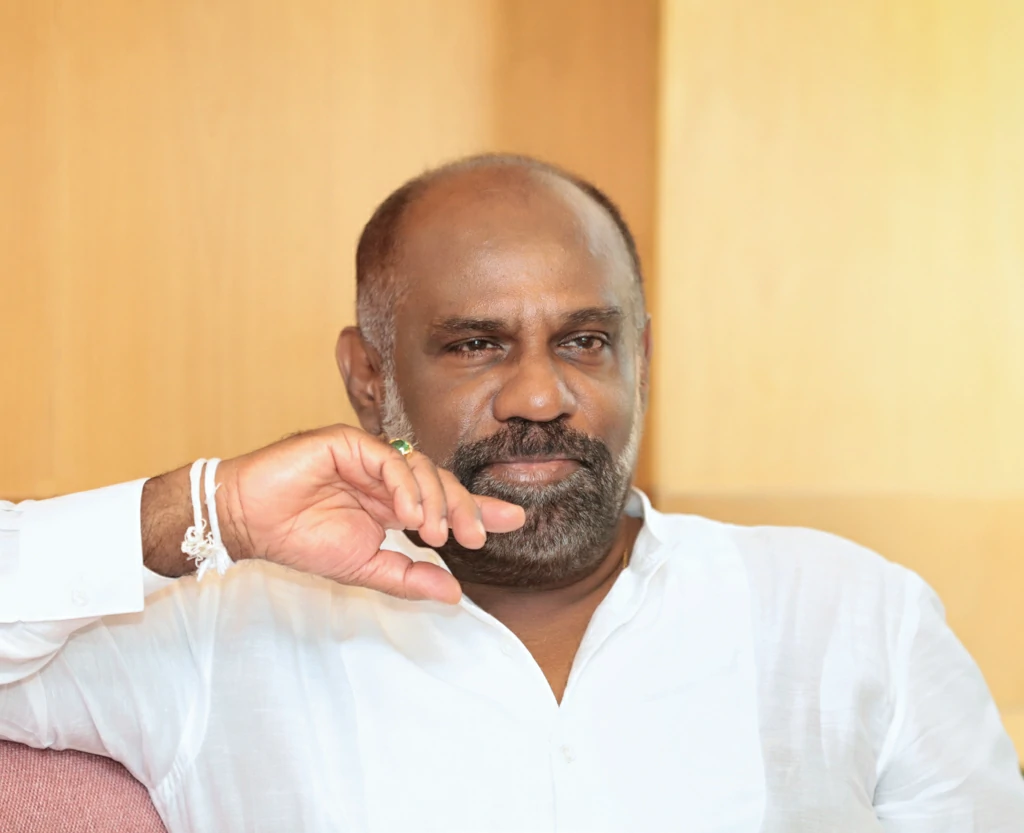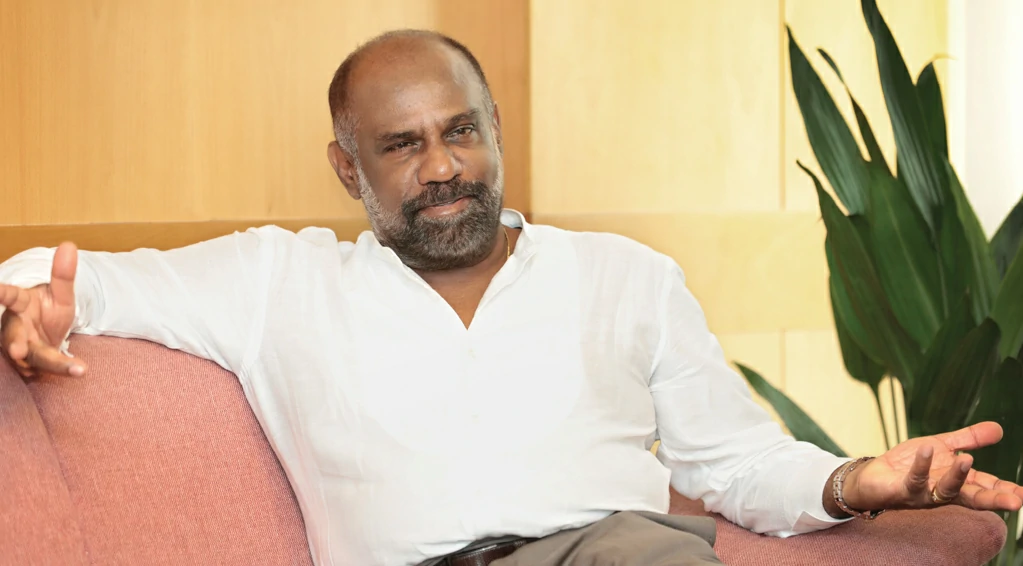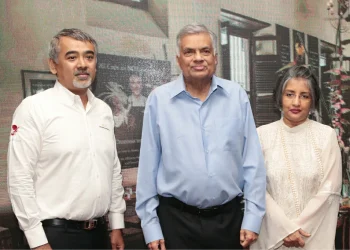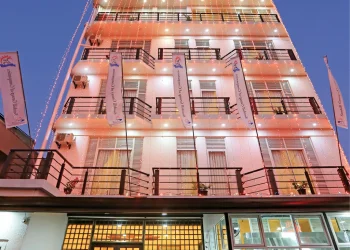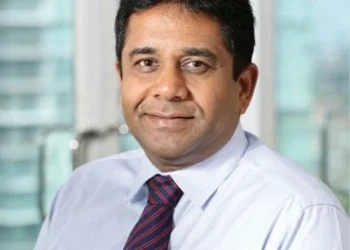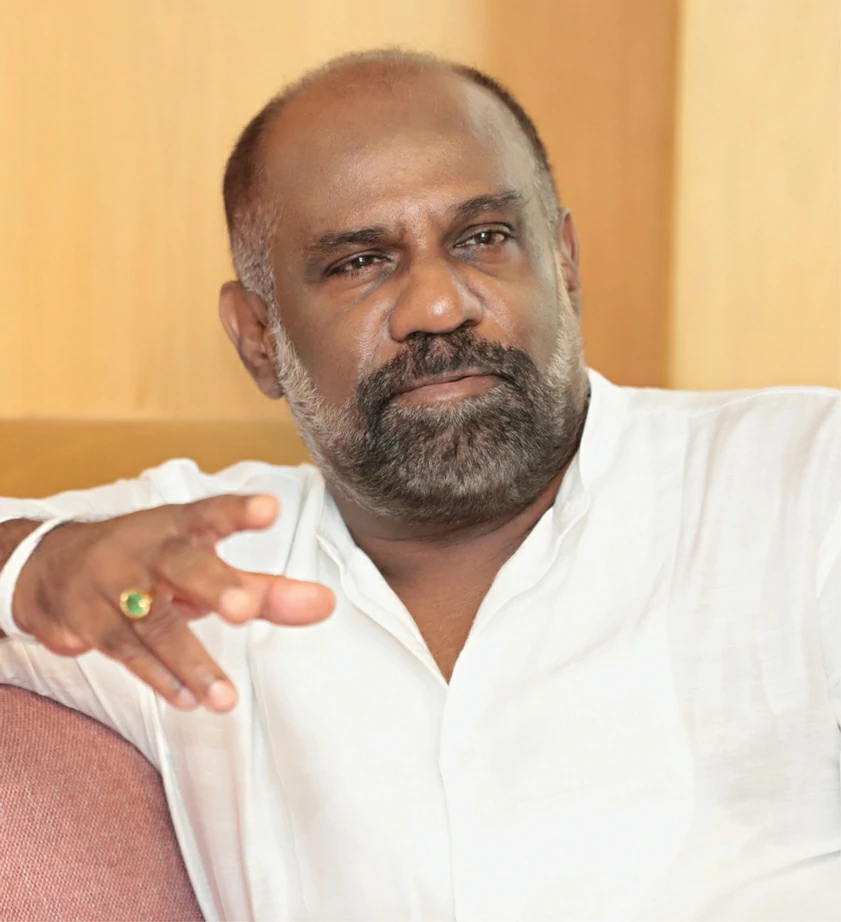
Thusitha Wijayasena, Chairman/Managing Director, Kandy City Centre (KCC) and Property Finance & Investments Kandy is a visionary, a businessman who does not merely consider profit margins. His landmark project, the KCC, has uplifted the central citadel through job creation among other factors. His latest venture, the film Aloko Udapadi has received acclaim both internationally and in Sri Lanka. Thusitha Wijayasena, along with his son Tharindu Wijayasena, Director, Property Finance & Investments Kandy speak about the latest initiatives at the KCC and reveal the journey behind Aloko Udapadi.
By Keshini de Silva | Photography Mahesh Bandara and Menaka Aravinda
Since its opening what have been the new inclusions to the Kandy City Centre? What was the thinking behind the establishment of the food court, café and children’s play area?
The main restaurant World Spice, which was opened in 2016, was designed in line with the island-like structure of the KCC. The concept here was to create a place where one family can sit for a meal, while each family member gets the chance to enjoy whichever type of cuisine they like. It is the same with my family, for one meal my daughter would prefer Chinese food, my wife Indian and I would prefer Thai cuisine. There are 460 varieties of food dishes served at World Spice, in the range of Chinese, Indian, Thai and Italian. There is also a fruit juice bar and a dessert counter.
Another key aspect was minimising wastage. We have introduced three portion sizes – small, medium and large – for meals, therefore, you can order based on your appetite, so this limits wastage. We focus on maintaining all fresh items that are healthy and of good quality. In addition, we use organic vegetables, and artificial flavours are not added. We also strive to maintain a very reasonable rate at KCC restaurants.
Café Walk, at the historic Walker’s Building entrance is quite popular among tourists. It was actually designed by Dan Amarasekara. The café concept was of course to market Sri Lankan grown Arabica. Restaurant and other expansions take place under Tharindu’s guidance.
I Chose Kandy Because It Was A Central Place. Today, The KCC Receives Large Crowds Of Up To 100,000 Per Day, With Visitors Travelling In From As Far As Mannar, Batticoloa And Jaffna.
The arcade, named WorldPlay, is a first for Sri Lanka. You would only find an arcade of that extent in countries such as Singapore. The 15,000 square feet indoor carpeted area has a merry-go-round, bowling alley, arcade games and bumper cars, all of which were imported from Japan. There is a variety of entertainment and the space accommodates upto 4,500.
KCC is not a conventional mall. How has it impacted the city of Kandy over the years?
Kandy, in the Central Province regardless of its historical significance, was a city, which was quiet and sleeping. I chose Kandy because it was a central place. Today, the KCC receives large crowds of up to 100,000 per day, with visitors travelling in from as far as Mannar, Batticoloa and Jaffna. We carefully designed the KCC to represent Kandyan culture. The building is also self sufficient as water and sewerage are all managed in-house.
Our services are devised to blend with the city too, for example, the KCC car park has been joined with that of the Kandy Municipal Council. The levels of the mall are also categorised according to each service and product range. For example, the first floor is dedicated to the 14 banks that operate at the mall and the post office, while Level 3 is for fashion; it is a popular section. Level 4 holds entertainment and food sections. On Level 7 we plan to have a gym, library, banquet hall and cocktail lounge.
The Kandy City Centre was opened in 2009. We struggled during the first two years. Our only occupants were Commercial Bank and the supermarket. However, today we have over 400 clients and visitors now know how to use the facilities at the mall.
In terms of KCC’s economic impact, Kandy used to be known for the Dalada Maligawa. Once people visited the temple, they did not have anything to do. KCC is the second key attraction in the city. On average, per day, we receive 4,000 foreign guests. Previously, there were limited jobs in Kandy; KCC has created 3,800 jobs within the mall. More than 5,000 opportunities have been created for suppliers, as well as the cleaning and maintenance staff. With an aim to develop our heritage arts and crafts, KCC organises exhibitions and provides a platform for event organisers. We have also provided opportunities to amateur performers who are now quite successful. The Annual Exhibitions such as ‘Vivaha’ – the Bridal Exhibition – provides exposure to small and medium scale entrepreneurs such as salons and dressmakers. Likewise, KCC has uplifted the economy of the central region of Sri Lanka by elevating the people and their quality of life. Turnover of the financial institutions at the mall is about three billion rupees per day.
Previously, There Were Limited Jobs In Kandy; KCC Has Created 3,800 Jobs Within The Mall. More Than 5,000 Opportunities Have Been Created For Suppliers, As Well As The Cleaning And Maintenance Staff.
Tourists are attracted to the KCC because food, entertainment, retail, banking services and the supermarket, they all come under one roof; everything is under one umbrella. In addition, tourists who shop at KCC know that they do not have to pay a commission, as we are very strict on that. A foreigner can shop in peace without hassle or worry, as the amount displayed is the rate of purchase.
What is your future vision for the KCC?
Are there any other initiatives in progress?
The KCC project is part of a larger master plan to develop the city of Kandy. It has been implemented in phases. In the 90s, the Urban Development Authority together with the then Government called for proposals to develop Kandy, because although both culturally and historically the city was of much importance, investment, at the time, was mainly concent-rated on Colombo and the coastal regions of the country.
The plan submitted by my father along with consultants in Singapore and architect Ashley de Vos in Sri Lanka was selected by a panel that included Geoffrey Bawa. Unfortun-ately, due to the change in Government and the resultant policy changes, this project was sidelined, despite this being a private funded project. At the time, my father had key assets in Colombo, however he took it upon himself to continue with the project and the mall. KCC, the mall, is Phase II of the Master Plan. He basically wanted to do it himself, even without the necessary Government infrastructure. That took a toll on him and his assets. We do not have a large board of directors or consultants, everything stems from his ideas. We merely implement what he wants to do. He is a man with a mission and a vision.
The construction of KCC took much longer than anticipated. There were significant budget issues; even the dollar was 38 rupees at the commencement of the project. However, my father never gave up. He was approached by many Middle Eastern, European, Indian and US investors to whom he could have palmed off the project. However, he wanted to prove that as a Sri Lankan entrepreneur with a vision he could complete a landmark project for the country. Despite the successful completion of Phase II, I do not believe my father wants to continue on to the next phase due to the time constrains and mammoth difficulties he has faced. Starting from official approvals, things take a lot of time in Sri Lanka. This is in fact a problem for investors and entrepreneurs like my father. If the Master Plan was implemented in its entirety, Kandy would have been one of the best hubs in Sri Lanka. It would also be a Pilot Project for similar cities in the South Asian region, which have similar develop-mental problems to Kandy.
Starting From Official Approvals, Things Take A Lot Of Time In Sri Lanka. This Is In Fact A Problem For Investors And Entrepreneurs Like My Father. If The Master Plan Was Implemented In Its Entirety, Kandy Would Have Been One Of The Best Hubs In Sri Lanka.
Kandy is developed inwards and due to its geography the city cannot expand outwards, unlike the city of Colombo, which can continue to expand into the suburbs in the outskirts. The Master Plan addressed everything from issues such as traffic, pollution and a lack of a sewage system. This was not just about building a mall and making money. If, all of the five phases were implemented then all would benefit more from the multi-storey car park, train station development, the 1,000 street shops, channeling centres that are linked to the Kandy General Hospital, a shuttle bus services and an amphi-theater as well as a convention centre. After all Kandy is yet to have such facilities, which in turn would uplift the heritage performing arts. The final phase included the cable car concept linking Kandy to Hantana. Many would assume the Government rejected the cable car project because it would result in much environmental damage. But that was not the case, my father has always been focused on ensuring that his projects are environmentally friendly and sustainable even before the 90s. This is before sustainability and environmental friendliness became hot topics. In the KCC, for example, we recycle water, which is in turn used for mall systems; we have a granite façade that naturally keeps the building cooler lending to minimum air-conditioning costs. Our A/C systems operate through a cooling motor system, which releases water vapor instead of harmful emissions. The water vapour released into the environment contributes to further cooling the city of Kandy.
Currently, we are working on the addition of cinemas to the Kandy City Centre. Initially, according to the Master Plan, four cinemas were planned to be built at the car park. Kandy is after all a transit city, it is always busy and there is always a crowd. To cater to this requirement you need a large cinema. When we launched the KCC in February 2009, my father wanted to continue on to the next phase. Unfortunately, he did not receive the help and assistance required by authorities or banks, so we gave up on that idea. But, as with malls in Singapore and the US, KCC too needed a cinema. As the Master Plan, which had received Cabinet approval, had allocated space for a cinema in the car park, space was not allocated for the cinema within the mall. Thankfully, we had a smaller plot of land, left undeveloped for a different purpose and we will be using that for the cinema; so we re-strategised and designed the 350-seat capacity multiplex to fit into that small plot of land. We have obtained approval and the cinemas will be completed ten months after the commencement of construction. It will be connected to the mall and will be equipped with US technology, acoustics from Singapore and seating most from either Italy or Japan. We want to use material and resources of the best quality and we anticipate that this will be the best cinema in South Asia. We are not cost leaders, so we do not go for cheap cost materials. It can be a double-edge sword due to the extent of investment required for such a concept, however you do not invest in such projects everyday. The KCC is a landmark project.
Do you plan on investing in a similar project in Colombo?
The Kandy City Centre project commenced in 1993, a time during which there was limited local investment in Sri Lanka. In addition to the World Trade Centre, 14 other significant development projects were in progression in Colombo. I thought to myself that, if Sri Lanka has a 2,500 year history, of which we are very proud of, why can we not undertake similar development projects in our own country. After all Singapore itself was developed by skilled Sri Lankans.
At the time, I owned 200 acres in prime locations in Colombo. I decided to take a risk in my young age. I had already earned enough through my vehicle business. My wife is from Kandy, and on the request of the Maha Nayaka, I decided that while everyone is developing Colombo, I will invest in Kandy to awake it from its slumber. In Colombo, there are many malls and similar centres. However, in Kandy there is only one mall, KCC. The value of the property has been significantly appreciated; in fact, you cannot place a set value on my mall today. I sold my properties in Colombo and invested everything in the KCC, and I dumped everything in one basket and that may even be an unwise business decision. However, it is a project with significant social benefit. I am a man of vision and am not one driven by profit.
While The Film Industry Worldwide Is Growing At A Rapid Pace, The Sri Lankan Industry Is In Decline. We Have Therefore Started A Cinema Company.
Why did you decide to venture into film production? Aloko Udapadi, your first cinematic initiative, follows two key events that took place during King Valagamba’s reign, why did you choose that particular plot?
Looking at the trend of investments in Sri Lanka, I thought to myself that everyone is building apartments, however while the film industry worldwide is growing at a rapid pace, the Sri Lankan industry is in decline. We have therefore started a cinema company. In the 1960s and 70s, Sri Lanka had 600 cinema halls yet today we have only 110. Even the quality of these cinemas has decreased. Currently, 30 locally produced films have a delayed release as the country does not have enough cinemas.
I knew Saman Weeraman, the script writer, very well as they purchased vehicles from me during the 1980s. He is also the director of the movie Siddhartha. Saman Weeraman met me and proposed this storyline. I studied the story and realised it was a good subject for a historical film, as the milestone historical event of Buddhist doctrine being committed to writing happened during King Valagamba’s reign. If the Tripitikaya and the Bible were not written, Buddhism and Christianity would not exist. In addition, after this milestone, Sri Lanka made its first export, Buddhism; we transported this doctrine across waters. King Valagamba’s reign was an inspirational one, as he led the country through Chola invasions and famine. Buddhism too was at risk, as the doctrine was transferred through recitation only, it was memorised by monks, a knowledge passed down from the senior monk to his disciple. During this time 24,000 monks lost their lives due to famine and devastation by the Cholas, therefore both the King and monks realised the philosophy needed to be committed to writing. Therefore, the central point for Theravada Buddhism was Sri Lanka.
There are many historical films produced in the country, however the focus is not placed on facts and in turn this damages the history of the country. We wanted to create something educational. Our team led by Director Chathra Weeraman worked quite hard, spending hours studying and reading up on the era. We believe they have done a great job with Aloko Udapadi.
What was it like to produce Aloko Udapadi? How did you select locations and what were the challenges you faced?
The main locations we selected were in Anuradhapura, Kalpitiya, Mannar, Sithupawwa and the Mahaweli areas. In total, there were 65 filming locations, 20 sets. The cast of 2,000 including 650 monks was the biggest cast in a Sri Lankan film. The movie budget was also a first for the industry. The team involved in the production of the film consisted entirely of new entrants.
In terms of the production journey, we first wanted to get the story right and to portray it accurately. Therefore, we first appointed a team consisting of professors specialising in Sri Lankan history to study the story. Before the first storyboard was designed, nine months was spent on research. We found that as there was not much written about King Valagamba, he did not have a spotlight in the Mahavamsa or any of the other chronicles. Therefore, we had to rely on other research sources for his information. Our research also focused on our attempts to accurately portray the specific places where the incidents took place. When filming commenced the team was at the site throughout. No breaks were taken. There was no consumption of meat or alcohol during production. I never visited the locations, and allowed the directors to handle the filming. I watched the clips from a screen in my office.
The Sri Lankan Film Industry Did Not Want A New Comer To Change The Status Quo. I Thought That Once I Took The Risk To Produce Something Of This Magnitude The Industry Would Look Up To It And Aspire To Improve. However, This Did Not Happen.
Inculcating an appreciation for Sri Lankan history was the aim of the movie. And we have been pleasantly successful in realising this objective. Sri Lankans should appreciate their history. The Chief Prelates have recognised the movie. Internationally as well as in Sri Lanka audiances have appreciated the film Aloko Udapadi.
We however did face many challenges. The film was completed two years ago, and all the circuits were keen to purchase the movie. However, I felt it was not the right time for a local release as there were many historical period films being screened at the time. Yet, we did screen Aloko Udapadi at many international festivals. Meanwhile, certain NGOs were opposed to the release of the movie as they felt the plot of the movie would cause issues. They assumed I was trying to instigate a problem. Even during the Aloko Udapadi Press Conference objec-tions were raised against the movie. Yet, the movie portrays history accurately; I do not believe it will trouble the future. I received many threats once the movie premiered in Sri Lanka. I did not sleep and at times even felt that those in the industry did not like me.
I suppose the film industry was opposed to change as I introduced new names and faces through the movie. The Sri Lankan film industry did not want a new comer to change the status quo. I thought that once I took the risk to produce something of this magnitude the industry would look up to it and aspire to improve. However, this did not happen. I was quite disappointed as although Sri Lankan professionals and those overseas appreciated Aloko Udapadi, those in the Sri Lankan film industry have not commented on my efforts. Only the directors, Udayakantha Warnasuriya and Sarath Weerasekara have acknowledged this film. The artistes have not appreciated this effort; perhaps as new names have been introduced through this movie.
We have the capacity to create 100,000 jobs in the Sri Lankan cinema industry today, however authorities are not ready to consider my suggestions. It is quite sad.
We Have Beautiful Film Locations Across The Island. We Must Harness These Resources And Uplift The Country.
What has been the reception overseas, especially at the international film festivals?
A year ago, we screened the movie at the United Nations Buddhist Festival. There, 2,000 people representing 95 countries participated in the event. On the day of the film screening, 41 countries confirmed that they want to purchase Aloko Udapadi. In fact, the movie was screened in Australia in March; although initially we thought we would be organising 20 screenings, eventually 100 screenings were booked across Australia. We hope to next screen in China, Vietnam, Burma, Russia, Europe, Canada and the US, as these countries are also requesting the movie.
On the other hand, in Sri Lanka, we find that there are people who have watched the movie even five to six times. Our Sri Lankan films, unlike Hollywood Blockbusters, usually do not have such a repeat audience. Theatres where we are screening the movie have told us that they have never seen families come to watch a film in such a number. Even on IMDb (the Internet Movie Database) the reviews for Aloko Udapadi are largely positive.
What is the potential of our film industry?
We found that there were not enough cinemas to screen the movie. We filmed Aloko Udapadi with the highest quality recording equipment, yet only 10 – 15 cinemas in the country can screen the film to its full potential.
Aloko Udupadi was, completely, filmed and produced in Sri Lanka. As Sri Lanka did not possess sound mixing and colour correction labs to the standard that we required, so we had to take the movie to the studios in India. However, everything else was done in Sri Lanka. Then, to screen the movie in older local cinemas we needed to transfer it to a 35 millimeter film. But we do not have facilities here to re-record the movie to a 35 millimeter film. Therefore, to transfer the movie to that old technology, we took it to India. When we were bringing the film back into Sri Lanka, we were charged a hefty tax. On the other hand, Indian and South Korean dramas are brought into Sri Lanka for as low as 10,000 rupees as it is listed in a different category.
How can the industry grow amidst such a scenario? It is very sad as Sri Lanka has good talent. Our film industry has potential. We have beautiful film locations across the Island. We must harness these resources and uplift the country.
